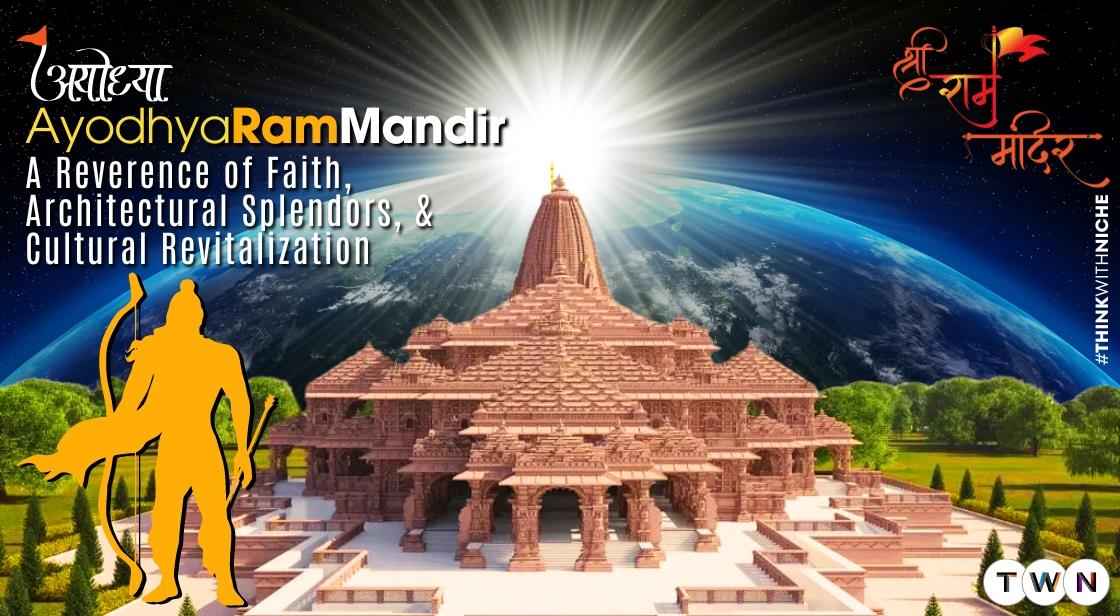Ayodhya Ram Mandir: A Reverence of Faith, Architectural Splendors, and Cultural Revitalization

Blog Post
Nestled in the sacred city of Ayodhya, the Ayodhya Ram Mandir, also known as Shri Ram Mandir, stands as a testament to the deep-rooted cultural and spiritual heritage associated with Lord Shri Rama.
The temple, dedicated to the revered deity, has its foundations embedded in the historical and religious landscape of Ram Janmabhoomi, the very birthplace of Lord Rama.
At the heart of this monumental creation lies the visionary craftsmanship of the Sompura family, led by the chief architect, Chandrakant Sompura.
The meticulous process involved unique measurements, as security constraints led Sompura to measure the site with his feet, laying the groundwork for a temple that seamlessly blends tradition and innovation.
The Ram Temple's architectural grandeur unfolds in the Nagara style, an aesthetic legacy tracing back to North India's late Gupta period.
Beyond spirituality, the temple complex houses essential infrastructure elements such as sewage and water treatment plants, fire service, independent power station, and a Pilgrims Facility Centre, reflecting a commitment to environmental consciousness and visitor well-being.
The completion of the Ram Mandir marks the end of decades-long religious discord, fostering religious harmony. Beyond its religious significance, the temple celebrates India's historical and cultural heritage, promotes social service, stimulates economic growth, and initiates infrastructural development in Ayodhya.
As Ayodhya Ram Mandir emerges as an architectural marvel, it transcends religious boundaries, inviting all to witness the union of tradition and progress. This divine edifice, steeped in cultural significance, weaves a narrative of unity, symbolizing India's rich tapestry of faith, art, and timeless spirituality.
This architectural marvel, with its intricate design and profound cultural symbolism, unveils a saga of devotion, unity, and timeless artistry.
Join us on a journey through the corridors of devotion, where the past, present, and future converge in the majestic embrace of Ayodhya Ram Mandir.
"Unraveling the layers of Ayodhya Ram Mandir, a symbol of devotion and cultural resurgence, from its architectural marvels to the grandeur of its consecration ceremony."
"Jai Shri Ram"
Unveiling Architectural Marvels of Ayodhya Ram Mandir
Who is the architect of the Ayodhya Ram Mandir?
The Chief Architect behind the creation of the Ayodhya Ram Mandir is Chandrakant Sompura. The inception of this monumental project dates back to 1989 when Ashok Singhal, the President of VHP (Vishva Hindu Parishad), initially approached Sompura to undertake the design and construction.
Sompura hails from a lineage of temple architects, boasting a remarkable portfolio of designing over 200 such structures across the nation. As per a Times Now report, he proudly represents the 15th generation within his family dedicated to the intricate art of temple architecture. Chandrakant Sompura's grandfather, PO Sompura, notably crafted the rejuvenated Somnath Mandir in Gujarat back in 1949.
The illustrious Sompura family is renowned for their contributions to various temples, showcasing an impressive list of architectural masterpieces. Among their notable works are the Akshardham temple complex in Gujarat, the Swaminarayan Mandir in Mumbai, and the renowned Birla Mandir in Kolkata.
Sent to Ayodhya to survey the designated site, Sompura encountered heightened security measures, necessitating him to employ a unique approach – measuring the space with his feet. From these measurements, he meticulously crafted three distinct designs, laying the groundwork for the temple's architectural blueprint.
As the years unfolded, Sompura's legacy continued through the collaborative efforts of his two sons, Nikhil and Ashish Sompura, who actively contributed to the realization of the Ram Mandir. The familial commitment to this sacred undertaking signifies a multigenerational dedication to the architectural manifestation of devotion, blending tradition and craftsmanship into the fabric of this historic structure.
Know about Sompura Sthapatya Foundation
The Sompura community comprises skilled sculptors renowned for their significant contributions to the creation of many splendid temples across India. Serving as architects, they play a pivotal role in preserving India's rich tradition and culture through architectural marvels. The Sompuras have elevated the art of temple construction to extraordinary heights, showcasing a fusion of robust rock-cut architecture and delicate, captivating sculptures. Their designs offer profound insights into the earliest forms of Indian religious architecture.
The Sompura architects are credited with crafting ancient temples such as the Somnath Mahadev Mandir, the world-famous Jain temples of Delwara-Palitana-Ranakpur, and the ancient caves of Ajanta-Ellora, among many others. Time-tested marvels like the Khajuraho temples, standing for over a millennium, and the centuries-old Delwara Jain temple stand tall as testaments to their craftsmanship. The creations of the Sompuras are not mere expressions of fame or individualism but stem from dedication, discipline, and pride in their craft. Each stone in a temple carries its own profound thoughts and expressions.
Interestingly, the meticulous work of the Sompuras involves extensive study and research for every aspect of temple construction, from the site selection to each individual stone, and from the foundation to the Dhwaja (flag). The designs incorporate proportions, details, and forms derived from in-depth studies of factors like Nakshatras (stars), Disha (directions), and the names of deities. It's noteworthy that traditional temple construction by Sompuras abstains from using steel.
The Sompura architects have devoted their talents to the world, infusing music into stone and narrating countless stories through their creations. Their legacy continues, marked by a commitment to the art of temple architecture.
Understanding the Architectural Marvel of the Ram Temple
The architectural marvel of the Ram Temple is characterized by its adherence to the Nagara style, a distinct form that traces its origins to North India during the late Gupta period. Built upon a robust stone foundation, the temple incorporates approximately two lakh bricks inscribed with Lord Ram's name in various languages, a collection spanning over three decades.
In the Nagara style, temples are traditionally elevated on a raised platform, housing the sanctum sanctorum beneath the prominent shikhara, reminiscent of a mountain peak. This unique feature stands as a hallmark of Nagara architecture. Typically, Nagara-style temples are adorned with murals and engravings embellishing the walls, complemented by a circumambulatory passage encircling the sanctum sanctorum, the sacred space where the deity is enshrined.
However, deviating from the conventional Nagara architecture, the Ram Mandir complex incorporates a notable deviation – a sprawling 732-meter-long wall. This departure from the norm, as seen in authentic Nagara-style temples, where distinctive boundary structures like gopurams are absent, adds a distinctive touch to the overall design of the Ram Mandir, blending tradition with innovative architectural elements.
Major Construction Materials Used in Ram Temple
The construction of the Ram Temple is distinguished by a meticulous selection of construction materials, showcasing a deliberate exclusion of steel or iron in favor of traditional elements, emphasizing sustainability and a connection to time-honored building practices. Key materials employed in the temple's construction include:
-
Bansi Paharpur Pink Sandstone: Sourced from Rajasthan's Bharatpur district, this exquisite sandstone constitutes the primary material for the main temple structure.
-
Granite Stones: Utilized in the plinths, granite stones contribute to the foundational strength and stability of the temple.
-
White Makrana and Colored Marbles: These materials are intricately employed for inlay work, adding an aesthetic richness to the temple's overall design.
-
Teakwood: Chosen for its durability and aesthetic appeal, teakwood finds its purpose in crafting the temple doors, adding a touch of traditional elegance.
-
Special Bricks (Ram Shilas): These unique bricks, inscribed with "Shri Ram," serve as a symbolic connection to the stones used in the construction of Ram Setu, bridging modern craftsmanship with ancient symbolism.
In addition to these primary materials, the construction incorporates a range of supplementary elements, including Shaligram Rock, Copper Plates, Gold, and Ashtdhatu, contributing to the overall architectural grandeur.
The architectural excellence of the Ram Mandir extends beyond material selection, encompassing various highlights:
Foundation of Ram Mandir:
-
A robust 14-meter thick layer of roller-compacted concrete, resembling artificial rock, forms the temple's foundation, ensuring structural stability.
-
A towering 21-foot-high plinth constructed from granite acts as a protective barrier against ground moisture, emphasizing the meticulous planning and execution of the temple's groundwork.
These architectural choices are a testament to the fusion of artistic vision and traditional building expertise, drawing inspiration from the study of around 550 temples across India. The culmination of these elements results in a temple design that stands as a remarkable blend of cultural heritage and architectural finesse.
Also Read: Exploring Top spiritual destinations in India and historical Ayodhya Dham
The Central Sanctum: A Testament to Artistry and Tradition
The primary sanctum of the Ram Mandir is crafted in the distinguished Nagara style, showcasing a captivating blend of traditional craftsmanship and aesthetic finesse. Originating in 1988, the initial design was conceived by the revered Sompura family of Ahmedabad, renowned for their legacy in temple architecture, including notable contributions to temples like Somnath. In a nod to timeless wisdom, the design underwent modifications in 2020, aligning it with the principles of Vastu Shastra and Shilpa Shastra.
The Sompura family's association with the temple design adds a profound historical and artistic dimension, ensuring a continuity of temple craftsmanship that spans generations. The temple structure unfolds across three stories, each meticulously designed to immerse devotees in the various stages of Lord Rama's divine journey.
Architectural Layers of Ram Temple Unveiled:
-
Ground Floor: A narrative unfolds, depicting the poignant tale of Lord Rama's birth and childhood, creating an immersive experience for visitors.
-
First Floor: Designed as Lord Rama's Darbaar, this level captures the regality and grandeur associated with the divine court of Lord Rama.
Ram Mandir Mandaps and Ornate Details:
The revered temple houses five Mandaps, each serving a distinct purpose – Nritya Mandap, Rang Mandap, Sabha Mandap, Prarthna, and Kirtan Mandaps. A total of 44 doors grace the temple, with some adorned with a lavish coating of 100 kg of gold, exemplifying opulence and devotion.
The main entrance, known as Singh Dwar, stands adorned with statues and busts, paying homage to prominent characters from the epic Ramayana. The pillars and walls within the temple are a canvas of intricate carvings, depicting India's rich historical tapestry and the pantheon of deities.
A Spiritual Journey Engraved:
As devotees traverse the parikrama path, they encounter a remarkable spectacle – 100 events from Valmiki's Ramayana intricately engraved on walkways and columns. This artistic endeavor, known as Ram Katha Darshan, serves as a visual chronicle, inviting visitors to engage with the profound narrative of Lord Rama.
In essence, the architectural marvel of the Ram Mandir transcends structural elements, weaving a narrative that seamlessly integrates aesthetic grace with profound spiritual significance. The temple emerges not merely as a physical structure but as a testament to cultural heritage and devotion, inviting worshippers into a sacred space where history and divinity converge.
The Holistic RamTemple Complex: A Spiritual Haven
Surrounded by a rectangular compound wall known as Parkota, the Ram Mandir stands as the focal point of a divine expanse. This impressive wall spans a length of 732 meters and boasts a width of 14 feet, encapsulating the sacred precinct.
Within the temple complex, a symphony of religious structures complements the grandeur of the main Ram Mandir. At each of the four corners, dedicated temples honor Surya Dev, Devi Bhagwati, Ganesh Bhagwan, and Lord Shiva. The northern arm hosts the temple of Maa Annapurna, while the southern arm embraces the temple of Lord Hanuman.
A testament to ancient heritage, the complex harbors the historic Sita Koop, a well that dates back to ancient times. The vision for the temple complex extends beyond its current state, with plans for additional temples dedicated to revered figures like Maharishi Vashishtha, Maharishi Valmiki, Maharishi Vishwamitra, Maharishi Agastya, Nishad Raj, Devi Ahilya, and Mata Shabri.
Nestled in the southwestern part of the complex, Kuber Tila beckons with the restoration of an ancient temple of Lord Shiva. Notably, an evocative bronze idol of 'Jatayu,' a character from the Ramayana, graces this sacred space.
The temple complex is not merely a spiritual abode; it encompasses essential infrastructure elements:
-
Sewage Treatment Plant: Reflecting a commitment to environmental consciousness, the complex features a sewage treatment plant.
-
Water Treatment Plant: Ensuring the purity of resources, a water treatment plant stands as a testament to sustainable practices.
-
Fire Service: Vigilance against unforeseen events is paramount, and a dedicated fire service infrastructure is in place.
-
Independent Power Station: Underscoring self-sufficiency, the complex hosts an independent power station.
-
Pilgrims Facility Centre: With a robust capacity of 25,000, this center provides pilgrims with essential medical facilities and locker amenities.
-
Sanctuary for Devotees: A designated block housing bathing areas, washrooms, washbasins, and open taps caters to the practical needs of devotees.
Learnings from the past have been incorporated into the temple complex's design, evident in the installation of around 200 KA light arresters. This proactive measure safeguards against potential damage caused by lightning strikes, drawing insights from historical temples in Mathura and Kashi.
Beyond its spiritual dimensions, the Ram Mandir aspires to be a cultural and educational hub. A museum within the complex curates artifacts that narrate the tales of Lord Ram and the Ramayana, transforming the temple into a holistic center where spirituality, culture, and education converge.
Other Architectural Facets of Ram Mandir
Beyond Temporal Boundaries: Unique Architectural Elements
Incorporating elements that transcend time, the Ram Mandir reveals intriguing facets that add to its mystique:
Preserving Identity for Eternity:
-
A time capsule, securely nestled 2,000 feet below the ground beneath the temple, cradles a copper plate etched with pivotal details about the Ram Mandir, Lord Rama, and Ayodhya. This innovative inclusion ensures that the temple's identity endures, safeguarding it from the erosion of time.
Resilience Against Earthquakes:
-
The temple is not just a monument of faith; it stands as an engineering marvel. Designed to withstand seismic forces, it boasts earthquake-resistant features, reinforcing its structural integrity.
Ancestral Shaligram Rocks:
-
The idols within the temple find their origin in 60-million-year-old Shaligram Rocks sourced from the Gandaki River in Nepal. These ancient rocks, steeped in geological history, lend a unique and profound essence to the spiritual space.
The Resonance of Ashtadhatu:
-
A colossal bell within the temple is a masterpiece cast from Ashtadhatu—a blend of Gold, Silver, Copper, Zinc, Lead, Tin, Iron, and Mercury. Weighing a remarkable 2100 Kg, its resonant chime echoes up to a distance of 15 Km, symbolizing the grandeur of the divine presence.
Each of these architectural nuances contributes to the temple's significance, bridging the temporal and spiritual realms.
The Nagara Architectural Legacy: Timeless Elegance
Unveiling the Nagara Style of Ram Mandir:
Originating in the 5th century AD and enduring in North India, the Nagara style of temple architecture embodies a timeless aesthetic. Distinctive features set it apart, complementing the basic elements inherent in all Hindu temples.
Essential Elements of Hindu Temple Design:
Sanctum Sanctorum (Grabhgriha):
-
A sacred space housing the principal deity, the sanctum sanctorum forms the spiritual nucleus of the temple.
Mandapa:
-
Serving as a portico or assembly hall leading to the sanctum sanctorum, the mandapa is a vital architectural facet.
Shikhara:
-
This pinnacle, reminiscent of a mountain spire, showcases versatile shapes from pyramidal to curvilinear, adding a distinctive touch.
Vahana:
-
The vahana, the mount or vehicle of the main deity, is strategically positioned just before the sanctum sanctorum.
Distinctive Traits of Nagara School:
Panchayatan Style:
-
The main shrine, situated on a rectangular plinth at the temple's center, is accompanied by four smaller subsidiary shrines at the corners, embodying the Panchayatan style.
Ganga and Yamuna Imagery:
-
Outside the Garbhagriha, images of river goddesses Ganga and Yamuna grace the temple, symbolizing divine purity and abundance.
Upraised Platform Construction:
-
Nagara temples typically rest on an elevated platform, elevating the spiritual space both symbolically and physically.
Pillared Portico Approach:
-
A pillared approach in the temple's portico adds to the grandeur, enhancing the visual and spiritual appeal.
Amalak and Kalash Summit:
-
The vertical end of the Shikhara culminates in a horizontal fluted disc known as Amalak, crowned by a spherical structure called Kalash, contributing to the temple's majestic silhouette.
Pradakshina Path:
-
Encircling the sanctum sanctorum, the ambulatory passageway, or Pradakshina Path, facilitates ritualistic circumambulation.
Significance of Ram Mandir’s Erection:
Religious Harmony:
-
The completion of the Ram Mandir marks the end of decades-long religious discord between Hindus and Muslims, fostering religious harmony.
Cultural Heritage Celebration:
-
The Ayodhya and Ram Mandir symbolize India's historical and cultural legacy, with the temple's construction serving as a tribute to the nation's rich heritage.
Social Service Promotion:
-
Anticipated charitable institutions around the temple are poised to promote social welfare, creating a positive impact on the community.
Economic Impetus:
-
As a major Hindu shrine, the Ram Mandir is expected to boost tourism in Ayodhya, stimulating economic growth and generating employment opportunities in the region.
Infrastructural Development:
-
The construction of the Ram Temple serves as a catalyst for infrastructural advancements in Ayodhya, paving the way for significant projects such as roads, airports, and industrial developments.
If you want this article read in hindi please click the link: जानिए क्या है Ayodhya Ram Mandir की विशिष्ट स्थापत्य कला औरआध्यात्मिक विशेषता ?
Conclusion:
The Ayodhya Ram Mandir stands as a testament to India's rich cultural and religious tapestry. Beyond being a religious edifice, it represents a profound connection to the spiritual heritage associated with Lord Shri Rama. The meticulous architectural planning, rooted in the Nagara style, showcases a harmonious blend of tradition and innovation. The Sompura family's multigenerational dedication adds a historical and artistic dimension to this sacred space.
The construction materials, including Bansi Paharpur Pink Sandstone and 60-million-year-old Shaligram Rocks, speak to a commitment to sustainability and reverence for ancient traditions. The temple's unique features, such as the 732-meter-long wall and the inclusion of a time capsule, add layers of innovation and preservation.
As the Ram Mandir emerges as a cultural and educational hub, it goes beyond its religious significance. It becomes a symbol of unity, celebrating India's collective spirit. The temple's completion signifies the end of religious discord, fostering harmony between communities. Additionally, the economic and infrastructural impacts are poised to stimulate growth in Ayodhya.
In essence, the Ayodhya Ram Mandir is a beacon of tradition, progress, and collective faith, illuminating Ayodhya's cultural renaissance and pointing towards a harmonious future.
You May Like
EDITOR’S CHOICE












